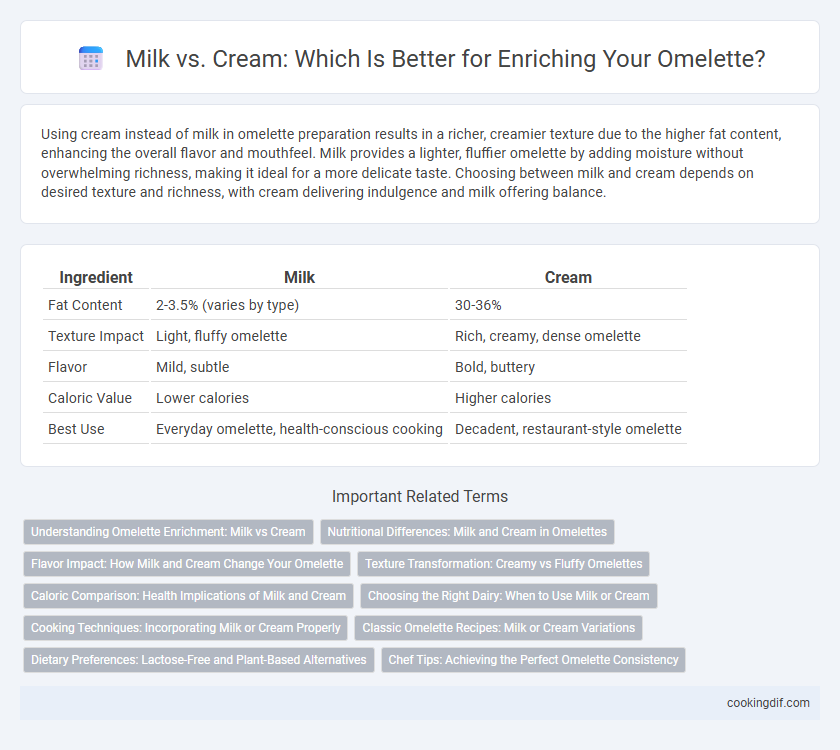Using cream instead of milk in omelette preparation results in a richer, creamier texture due to the higher fat content, enhancing the overall flavor and mouthfeel. Milk provides a lighter, fluffier omelette by adding moisture without overwhelming richness, making it ideal for a more delicate taste. Choosing between milk and cream depends on desired texture and richness, with cream delivering indulgence and milk offering balance.
Table of Comparison
| Ingredient | Milk | Cream |
|---|---|---|
| Fat Content | 2-3.5% (varies by type) | 30-36% |
| Texture Impact | Light, fluffy omelette | Rich, creamy, dense omelette |
| Flavor | Mild, subtle | Bold, buttery |
| Caloric Value | Lower calories | Higher calories |
| Best Use | Everyday omelette, health-conscious cooking | Decadent, restaurant-style omelette |
Understanding Omelette Enrichment: Milk vs Cream
Using milk in an omelette enriches the texture by adding moisture and lightness, resulting in a fluffy and tender consistency. Cream, with its higher fat content, creates a richer, denser omelette that is more indulgent and velvety. The choice between milk and cream influences both flavor and mouthfeel, with cream providing a luxurious taste and milk offering a balanced, lighter alternative.
Nutritional Differences: Milk and Cream in Omelettes
Milk in omelettes provides a lower calorie and fat content while contributing essential nutrients like calcium and vitamin D, supporting bone health. Cream offers a richer texture and higher fat content, supplying more calories and fat-soluble vitamins such as vitamin A, enhancing flavor and creaminess. Choosing milk results in a lighter omelette with more protein concentration, whereas cream creates a more indulgent, energy-dense dish with increased saturated fat.
Flavor Impact: How Milk and Cream Change Your Omelette
Milk adds a subtle creaminess to an omelette, enhancing its texture without overpowering the eggs' natural flavor. Cream imparts a rich, velvety taste that makes the omelette noticeably more indulgent and luxurious. Choosing cream over milk intensifies the flavor profile, making each bite smoother and more decadent.
Texture Transformation: Creamy vs Fluffy Omelettes
Using cream instead of milk in an omelette enriches the texture by increasing fat content, leading to a creamier and denser result. Milk yields a lighter, fluffier omelette with a more airy interior due to its higher water content. Choosing cream over milk significantly influences the omelette's mouthfeel, shifting it from delicate fluffiness to rich creaminess.
Caloric Comparison: Health Implications of Milk and Cream
Milk contains roughly 42 calories per 100 ml, making it a lower-calorie option for omelette enrichment compared to cream, which has about 340 calories per 100 ml. The higher fat content in cream increases the calorie density significantly, potentially contributing to weight gain and higher cholesterol levels if consumed frequently. Choosing milk over cream can help reduce overall calorie intake and support heart health while still providing a creamy texture to the omelette.
Choosing the Right Dairy: When to Use Milk or Cream
Choosing the right dairy for enriching an omelette depends on the desired texture and richness. Milk creates a lighter, fluffier omelette with a subtle creaminess, while cream results in a richer, denser texture with enhanced flavor depth. For a delicate breakfast, use milk; for a decadent brunch, cream is ideal.
Cooking Techniques: Incorporating Milk or Cream Properly
Incorporating milk or cream into an omelette requires precise technique to achieve a tender, fluffy texture. Use a small amount--about one tablespoon per two eggs--and whisk thoroughly to ensure even distribution without over-diluting the eggs. Cream adds richer fat content, creating a silkier mouthfeel, while milk lightens the mixture, so adjust cooking temperature and time to prevent curdling or browning.
Classic Omelette Recipes: Milk or Cream Variations
Classic omelette recipes often debate using milk or cream for enrichment, with milk providing a lighter texture and cream yielding a richer, fluffier result. Milk's higher water content dilutes the egg mixture slightly, creating a tender, delicate omelette, while cream's fat content enhances moisture and flavor intensity. Choosing between milk and cream depends on the desired richness and texture, influencing the final mouthfeel and culinary experience.
Dietary Preferences: Lactose-Free and Plant-Based Alternatives
Milk and cream are traditional ingredients used to enrich omelettes, but lactose-free and plant-based alternatives like almond milk, oat milk, or coconut cream cater to dietary preferences and lactose intolerance. These substitutes maintain a creamy texture while avoiding dairy allergens and supporting vegan diets. Choosing fortified plant-based options helps preserve nutritional value, including added calcium and vitamins.
Chef Tips: Achieving the Perfect Omelette Consistency
Using cream instead of milk in your omelette mixture increases fat content, resulting in a richer, silkier texture and a fluffier consistency favored by professional chefs. Milk dilutes the egg proteins more than cream, leading to a lighter, less creamy omelette that can sometimes turn rubbery if overcooked. For the ideal omelette, blend one tablespoon of heavy cream per two eggs to achieve optimal moisture retention and a tender, smooth bite.
Milk vs Cream for omelette enrichment Infographic

 cookingdif.com
cookingdif.com